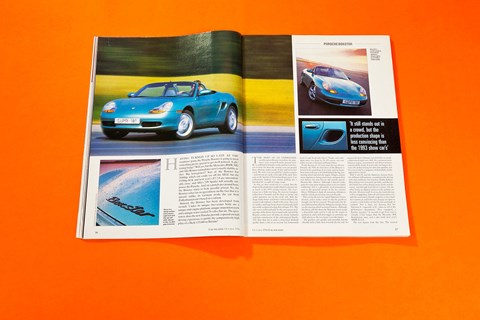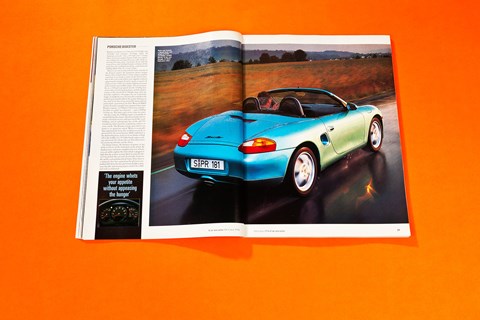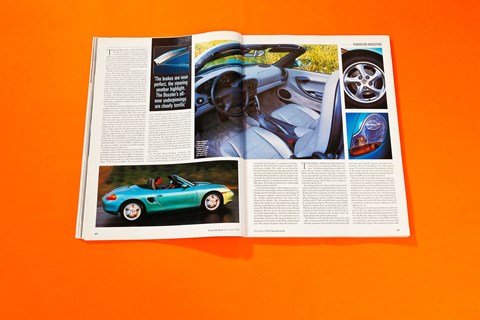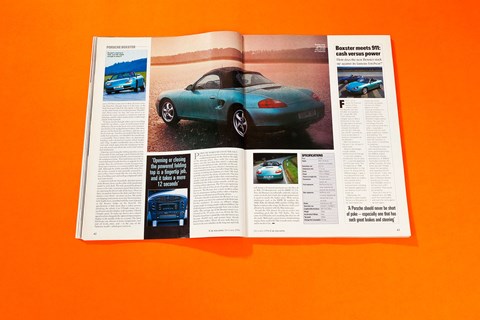► Georg Kacher, 1996, the Porsche Boxster
► Our first drive of the first new Porsche for 19 years
► An archive gem as part of CAR+
Having turned up so late at the roadsters’ party, the Porsche Boxster is going to need something pretty special to get itself noticed. A glistening badge? Well yes, but Mercedes, BMW, MG and Alfa Romeo nameplates aren’t exactly shabby, either. Big horsepower? Sort of: the Boxster has 204bhp, which can easily see off the MGF, but the 193bhp SLK and next year’s Z3 2.8 are uncomfortably close, and Alfa’s 24v Spider will actually out-power the Porsche. And on a punch-per-pound basis, the Boxster starts to look greedily priced. No, the Boxster relies for its specialness on the fact that it is special: unlike its German rivals, the car from Zuffenhausen isn’t based on a saloon.
Instead, the Boxster has been developed from scratch. Under its unique two-seater body are a unique mid-engine platform, unique suspension parts and a unique water-cooled 24-valve flat-six. The question is: does the new Porsche provide a special enough driving experience to justify the comparatively high price of a likely £35,000 in Britain?
The sight of an undisguised metallic-green Boxster transfixes the populace, even around Porsche ground zero. We’ve collected it from the works and we’ve no reason to stray far from the vicinity: you can pound these alluring, snaky roads all day and never feel sated. We were even recorded by a police camera – and not one on a pole at the side of the road. Two cops in the hamlet of Schwieberdingen gave it an enthusiastic looking over before pulling out a sureshot for a couple of happy snaps.
So this car does stand out in a crowd. But the shape of the production model doesn’t convince me as much as the 1993 styling exercise. The overhangs are a little too long, the massive bumpers rather heavy-handed, and the deep air intake and outlet apertures are on the crude side. Still, the shape looks better with familiarity. Its sunniest side without a doubt is the nose. Two oval air intakes and large lamp clusters lead neatly back into softly sculptured wings that whisper 911. The side view is enlivened only by the curvaceous trailing edge of the doors. Get around to the tail and the Boxster comes over all retro, its classic buttocks and hips reminiscent of the mid-engined Spyder 550. Into that lot is sunk a motorised ducktail spoiler that’s a bit of an eyesore but fortunately rears its ugly head only above 75mph, and sinks again once you drop to 50. Of course, our aim today is to get it elevated and keep it there.
If only because it’s 19 years since the last all-new Porsche, the 928, the first drive of the Boxster is bound to be something of an event, and my heartbeat seems to know it as I climb behind the big, low steering wheel and start the engine. Despite current noise regulations being much more stringent than ever before, the new flat-six still sounds special. Porsche-like. Alleluia. Although it doesn’t make quite the same spine-tingling noises as its air-cooled stablemate, this is a pleasantly vocal powerplant even in the peaceful sectors of the rev-counter. Above 5000rpm it sheds all remaining inhibitions and the velvety growl turns into real thunder.
This car has the new five-speed Tiptronic S transmission, and it makes sense to slip the gearlever straight into M-for-manual. This provides the desired Schumacher effect by letting me change ratios via the steering wheel-mounted buttons. Although the driver calls the shots, the Tiptronic won’t accept a downshift order until it is safe for the engine to perform, and it will also trigger an automatic upshift whenever the revs home in on the limiter.

The gearbox acts quickly and smoothly, but the throttle feels a little slow towards the far end. To squeeze the final 1000rpm out of the flat-six needs a determined right foot. Still, the communication between engine, transmission and driver remains commendably sharp. It won’t take you long to discover the perfect timing for ultra-fast upshifts, and it’s a joy to dial in a sequence of downshifts on the approach to a bend.
Slide it into D, and the Tiptronic chooses from five different shift patterns, according to the driving style and conditions. For instance, briskly dethrottling will prevent unwanted upshifts, and the box also holds low ratios during steep climbs and descents, and through hard-driven corners. On the other hand, on slippery surfaces early upshifts are the rule. All clever stuff. Even so, dry-roads driving in D is unappealing. Take-off is hesitant unless you stab the accelerator, throttle response is too casual for a sports car, and if the ratio changes are spot-on at times, a mile further on they’ll come seemingly at random. Nor is there any denying that the Tiptronic S – especially in D – takes its toll in the performance department. Thus equipped, a Boxster occupies 7.6 seconds to get from rest to 62mph, 0.3sec longer than the Mercedes SLK Kompressor auto, and it also trails next year’s BMW Z3 2.8.
The raw figures look like this. The manual Boxster accelerates in 6.9sec from 0-62mph, tops 150mph and averages 39.1mpg, while Tiptronic records 7.6sec, 147mph and 37.2mpg. These fuel consumption figures look very impressive indeed, but our specimen was sadly adrift, returning 18.2mpg after a hard day. Even with the manual box, the 204bhp Porsche is slower off the mark than the 120bhp Lotus Elise, and it beats the 145bhp MGF VVC by 0.8sec.
There’s not a lot wrong with the basic attitude of the Boxster engine. Its maximum power out betters that of most other 2.5-litre engines, and the eagerness to rev keeps a smile on the driver’s face. But in the end it just whets your appetite without appeasing the hunger. It rarely excels or excites. It needs an extra 500c for a larger helping of muscle in the bottom and middle ranges. You can’t grumble at a 150mph top speed, but the 1300kg two-seater takes its time getting there, and the performance in the crucial 45 to 90mph range isn’t sufficiently explosive. On paper, the car is perfectly happy at moderate revs, but in reality it needs to be pushed quite hard to deliver the goods. Doing so is fun, and yet it’s also noisy, eventually tiring and not particularly economic. In their Weissach R&D centre, Porsche’s people have prepared two more Boxster engines: a 170bhp 2.0-litre four-cylinder – for their so-called ‘eco scenario’ – and a 240bhp 3.0-litre six. The latter can’t arrive a day too soon.
On dry roads, the 204bhp engine is incapable of overwhelming the chassis. Sensational grip and virtually unlimited traction add up to leech-like road holding, and it’s refreshingly free of the old 911 wandering when faced by undulating surfaces or cross winds. The Boxster simply goes where you point it, no questions asked. When it eventually does approach the limit, the car behaves exactly as promised by the manufacturer. Mild understeer is the dominant trait, and even if you brake or back off in the middle of a 10-10ths bend, expect nothing untoward. It’s always the car that determines the cornering attitude, not the driver.
On damp tarmac, the balance of power at last shifts in favour of the individual at the wheel. By feeding more and more oomph to the rear wheels, you can safely explore the limit which is pegged so high that the g-force is more likely to turn the driver’s head than the car’s tail. Eventually, however, the stubby rear end does break loose. Since there is a relatively fine line separating the glorious controlled slide from the less glamorous helpless spin, your throttle and steering inputs need to be subtle and well co-ordinated.
The brakes are close to perfect. The Boxster requires only 2.7sec to decelerate from 62mph to complete a standstill, equal to a stopping distance of 37.7 metres. I try three simulated high-speed emergency stops: they leave the four discs totally unfazed. The pedal feel is a touch on the heavy side, but its action is progressive and easy to modulate. You need to drive like a real maniac before you’re going to trigger the ABS for more than an instant.

Another dynamic highlight is right there in your hands. The assisted steering is ideally geared, requires exactly the right effort, and remains interested no matter how much lock you wind on. I’m sure that some drivers would prefer a slightly lighter and quicker calibration, but that would make the car more nervous and less sure-footed in its actions and reactions. Considering the potentially delicate mid-engine layout, the direction-finder is just fine the way it is. Unlike certain other Porsches – the 968 Turbo S and the 911 RS spring to mind – the Boxster rides quite well. It’ll occasionally buck over transverse ridges or manhole covers, but in general the springs and dampers are sufficiently compliant, without letting the body heave unchecked.
So the Boxster’s all-new underpinnings are clearly terrific from the word go. The basic deal is four MacPherson struts, supported by lateral and longitudinal links of aluminium alloy. The same stuff also serves for the hub-carriers, front crossmember and rear subframe. Elaborations of the 928’s ‘Weissach axle’ elastokinematics provide negative toe-in at the outside front wheel and positive toe-in at the outside rear wheel. That’s why, as the g-force builds up, the car duly understeers and scrubs off speed. At the same time, lift off oversteer is greatly reduced. The brakes use lightweight four-piston callipers, ventilated discs all-round and fifth-generation ABS. The standard size is 205/55 ZR 16 in the front and 225/50 ZR 16 in the back, but your friendly Porsche salesman will probably tempt you with 205/50 ZR 17 and 255/40 ZR 17 affairs as per the test car, and then, of course, sir will be wanting the optional sports suspension.
And the engine? There’s nothing wrong with its conception, either. The deficiency is a matter of degree rather than of type. The 2480cc six produces a maximum power output of 204bhp at 6000rpm. The torque curve peaks at a fairly busy 4500rpm, where 177lb ft are available. The car could use more: the SLK has 203lb ft over a more accessible range. Don’t confuse this all-new water-cooled boxer engine with the 911’s classic air-cooled flat-six, by the way. But if it’s different in substance, it’s still in spirit a sporty powerplant that responds promptly to throttle orders and displays a cheering willingness to rev. Crank and pistons are forged, and the short-stroke cranks sits in seven bearings, additionally supported at each end by an alloy-iron bearing bracket that’s secured to the aluminium engine housing. The open-deck engine block looks bigger than a 911’s because of the water jackets that surround it. The block also accommodates a large oil reservoir to feed the dry-sump lubrication system. Unlike the 911, the Boxster manages without an external oil reservoir and the plumbing that goes with it.
An oil-water heat-exchanger accelerates the warm-up phase by letting the engine oil heat the coolant. Above 80degC, or whenever the oil threatens to get hotter than the coolant, the process is reversed. For the first time in a production Porsche, except the 959, this boxer engine employs four valves per cylinder. The intake set are driven by Porsche’s familiar Variocam adjustment device. The two twin-cam single-spark-plug cylinder heads are absolutely identical. Each has a chain cam drive: for one back it’s at the flywheel end, for the other at the opposite end. It’s an arrangement that saves valuable space. The heads are spanned by a lightweight synthetic intake manifold.
A mid-mounted engine is demanding to cool, so Porsche first tried a large radiator behind the front bumper, but that left little room for a front boot. So the engineers adopted a solution from the 959, of two smaller radiators sitting in the front wings ahead of the wheels. This arrangement has a lot more to be said for it, by also improving weight distribution and helping to reduce front-axle aerodynamic lift. The holes aft of the doors serve different purposes. The one on the left sucks intake air; the one on the right employs a small fan to flush hot air out of the engine bay. The car’s underside is snowboard-flat, which cuts the drag coefficient by six percent (to 0.31) and rear axle lift by a huge 36 percent. The active tail spoiler slices lift some more.
Thumbing through the manual is the only way to-glimpse the Boxster’s engine. A full-page portrait has to suffice because the real thing is hidden from above and below and the only contact is through a small service panel inside the rear boot. This accommodates a long dipstick, the filler caps for oil and water, and a transparent gauge which allows you to approximate the coolant level.
According to Porsche, this sealed tamper-proof engine installation is a good thing because it complies with forthcoming US safety rules, and because the Boxster’s boxer requires very little maintenance. The electronics can be checked via an external plug-in diagnostic system, and the cam chains and ancillary poly-V belts are both kept in good shape by automatic tensioners. The direct ignition and the hydraulic tappets don’t need looking after, either. This leaves the mechanic to deal with easily accessible air and oil filters. Only at 60,000 miles is more intimate spanner-work needed, when the spark plugs come up for replacement.

The Boxster is the first Porsche that can be had with a traction-control (TC) device. With the help of brake actuation and a black box that reduces fuel feed and retards ignition, wheelspin is effectively ruled out throughout the entire speed range. TC can be deactivated by pushing a button in the centre console. Even when the system has been switched off, the progressive limited-slip differential (ABD) remains fully functional.
The car’s modular assembly structure is largely responsible for the strong torsional rigidity and what is claimed to be excellent crash performance. New welding techniques, reinforced body sections, high strength steels, various clever compound elements and generous crumple zones (partly the cause of the lengthier nose than the show car’s) all help to keep the weight down and to ensure impeccable passive safety. The occupants are not only protected by dual airbags, but also by roll-bars, door beams and a beefed-up windscreen frame. Sidebags will be added next year.
The Boxster’s body designers deserve credit not just for the car’s appealing looks but also for the fine job they did in the packaging department. You see, the Boxster offers not one luggage compartment like the Z3 (180 litres) or the SLK (145 litres on a sunny day), but two; one in the nose-cone, and one behind the engine. The combined volume adds up to 260 litres come rain or shine. If you’re carrying chocolate, though, keep it in the nose, as the back boot gets baked by the engine. Cabin space, on the other hand, isn’t overly generous. Shoulder – and elbow – room are fine, but seat travel is restricted, the centre console is a touch too wide for long legs, and the wheel-arches claim a rather large chunk of the footwell.
To keep out the draught when you’re travelling with the top down, a pair of mesh-screen wind-deflectors clip on to the head-rests, and a transparent shield can be wedged between them. Like most devices of this kind, the anti-breeze add-ons are a bit of a lash-up – but then, if you don’t like the wind in the hair sensation, you shouldn’t be considering a convertible. Extra money buys an aluminium hardtop, with a heated rear screen, which weighs only 25kg. Another worthwhile extra is the clever roof rack which spans from the windscreen to the rear side panels and allows the roof to furl and unfurl unimpeded.
Opening and closing the folding top takes a mere 12 seconds. It’s by-and-large a push-button job, but you need to unlatch or latch the canvas structure to the windscreen frame. That latch turns out to be an overstyled metal handle that has an appetite for fingertips. Since the roof frame is made of magnesium from top to bottom, it is commendably light and stiff. Although the whole assembly folds away flat, the stylists wanted it only partially covered by a steel collar. I don’t much like the way this leaves bits of welding seam and sealing compound visible and unprotected.
Compared with the beautifully detailed interior of the Boxster show car, the cabin of the production model is, well, drab. The only ground-breaking element is the lofty instrument panel that forms an are spanning the driver’s side of the facia. There are three air pockets between the dials and their foundation: a nice detail – no more, no less. The partly overlapping instruments wear arty but not particularly legible faces, inscribed with the same typestyle as the Boxster badge on the boot-lid. The speedometer is little more than a token gesture, shrinking the whole 0 to 155mph range into a small semi-circular display, with numbers 50km/h (31mph) apart. To make up, there’s also a digital speed readout alongside the optional trip computer display in the middle of the rev-counter. The third dial keeps you abreast of water temperature, fuel and oil levels, time, and – in the case of the Tiptronic model – which gear you’re in.
Porsche makes much of fact that the Boxster’s ignition lock remains in its traditional position on the dash to the right of the steering wheel. They make less song and dance over the fact that the wheel is adjustable only in reach and not in rake. And why are the controls that operate the (very effective) automatic climate control so tiny that a fat index finger like mine is prone to hitting two buttons at a time? My final grumble concerns the choice of materials. Our test car was clad in supple leather that contrasted too starkly with the low-rent door trim, the synthetic dashboard, the shaky centre console, and the unexciting colour spectrum. The 911 is an ergonomic mess, but at least it has an air of quality and tradition to it. The Boxster has a more modern cabin, but its anonymous styling neither takes a leap forward nor recalls past great Porsche glories.
Porsche intends to position the Boxster as ‘a serious sports car, not to be confused with those just-for-fun roadsters’. If you’re an affluent ‘empty nester, single or young couple without children,’ the Zuffenhausen marketing people have you in their sights. The average age of the Boxster owner is estimated to be 35 years, vis-a-vas 44 for the 911. Porsche must have a good idea who the buyers are because 16,000 men and women have already placed firm order. That’s all very well, but it remains to be seen whether in the long run such folk will stump a 20-percent premium over the likes of an SLK 230 Kompressor and the BMW Z3 2.8. True, the Boxster can outhandle, outbreak and outcorner its rivals, but I lacks the simple performance it needs to justify the higher price. With serious challengers such as the BMW M Roadster, the AMG SLK, the Honda SSM and the 232bhp Alfa Spider waiting in the wings, the Boxster really can’t afford to be content with the bhp status quo.
It took the 924 almost 10 years to evolve into something great like the 944 Turbo. The new entry-level Porsche isn’t anything like that far off the mark. With such a great chassis and promising engine, how could it be? But it needs more oomph, and it needs it fast.

Specifications
Price: £35,000
Engine: 2480cc 24V flat-six, longitudinal, mid-mounted
Bore/stroke,mm: 85.5/72.0
Compression ratio: 11.0 to one
Power: 204bhp at 6000rpm
Torque: 177lb ft at 4500rpm
Power-to-weight ratio: 157bhp per tonne
Transmission: Five-speed, manual or Tiptronic, rwd
Front suspension: MacPherson struts, coil springs, longitudinal and transverse links, anti-roll bar
Rear suspension: MacPherson struts, coil springs, longitudinal and transverse links, tie rod, anti-roll bar
Brakes: Ventilated discs, ABS
Tyres front, rear: 205/50ZR 17, 255/40ZR 17
Length/width/wheelbase: 690/1593/2148mm
Weight: 1300kg
Acceleration (0-62mph): 6.9sec
Top speed: 150mph
Average fuel consumption: 39.1mpg